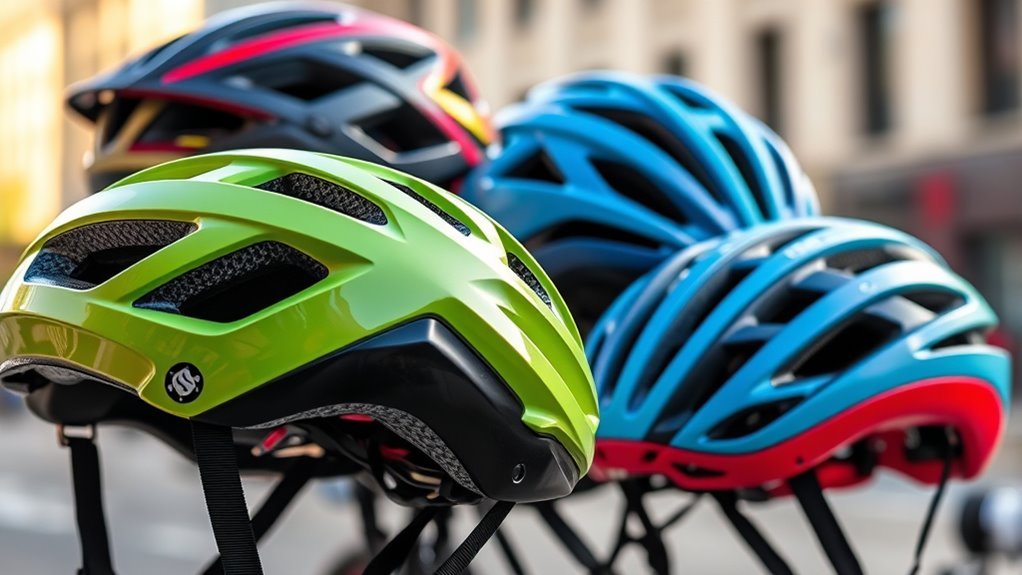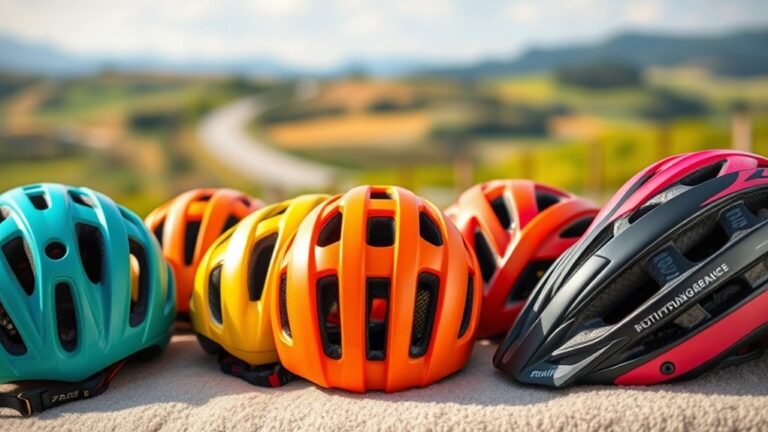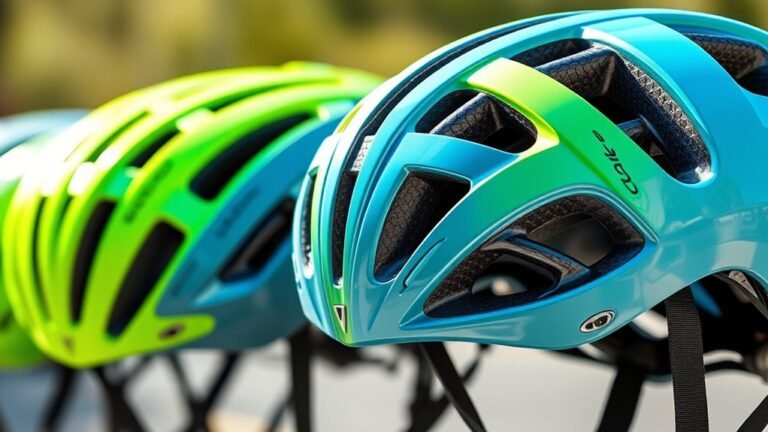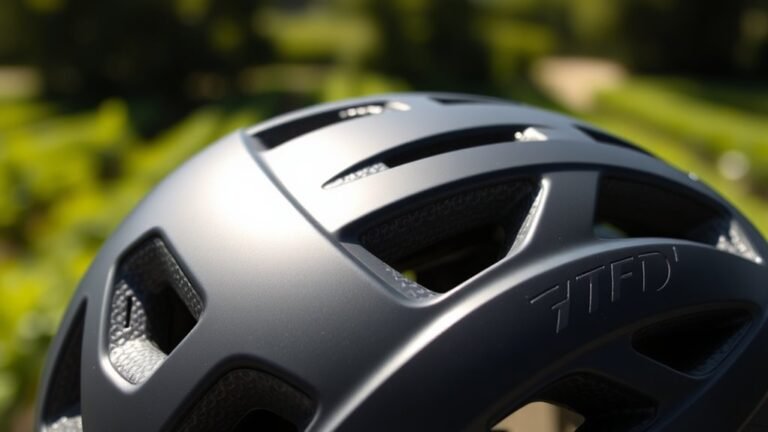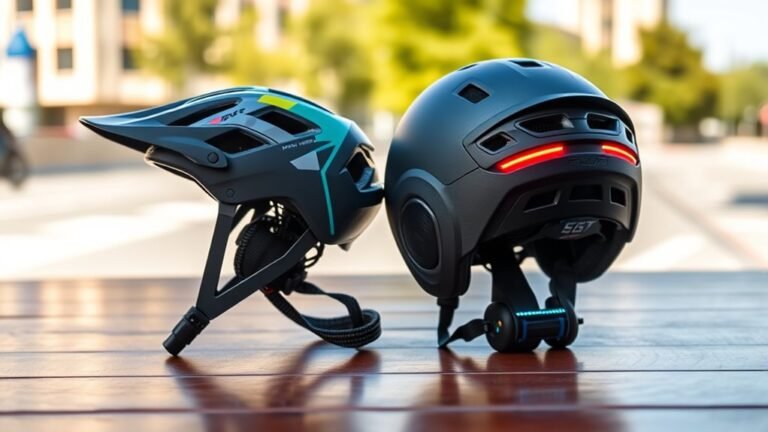Top-Rated Commuter Bicycle Helmets
When searching for top-rated commuter bicycle helmets, consider models that prioritize safety and comfort. Helmets like the Giro Caden and Bell Local offer excellent ventilation and durability. Look for compliance with safety standards, as this guarantees protection. Features such as reflective materials and adjustable vents enhance visibility and comfort. A proper fit is vital for effectiveness, so checking sizing is essential. To find out more about selecting the best helmet for your needs, continue exploring additional insights.
Importance of Wearing a Bicycle Helmet
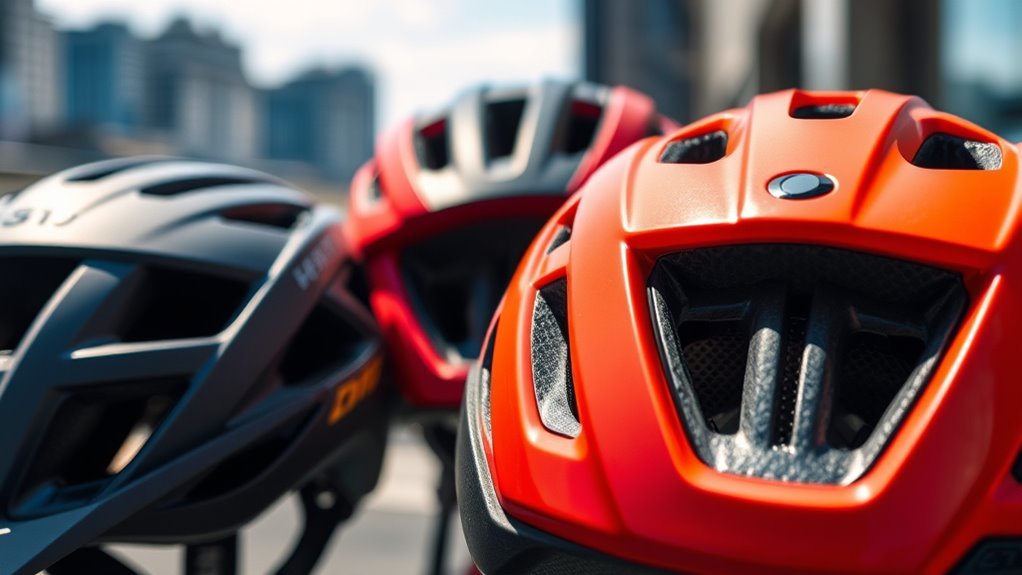
When you ride a bicycle, wearing a helmet isn’t just a suggestion; it’s an essential safety measure that can greatly reduce the risk of head injury in the event of an accident. Helmet safety is paramount, as studies show that wearing a helmet can decrease the likelihood of severe injuries by up to 85%. Many cycling regulations advocate for helmet use, emphasizing its importance in promoting safer riding environments. By adhering to these regulations, you not only protect yourself but also contribute to a culture of safety within the cycling community. Freedom on the road is exhilarating, but it comes with responsibilities. Prioritizing helmet safety is a vital step toward ensuring that your cycling adventures remain enjoyable and injury-free.
Key Features to Look for in a Commuter Helmet
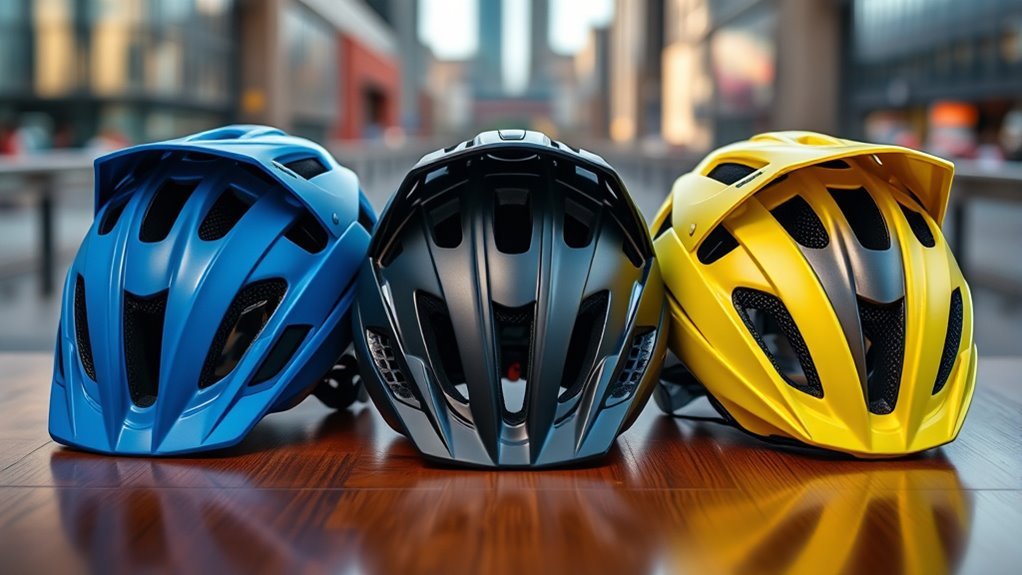
When choosing a commuter helmet, it’s essential to guarantee it meets safety standards to protect you effectively. You should also consider ventilation and comfort, as these features can greatly enhance your riding experience. By focusing on these elements, you’ll find a helmet that not only prioritizes safety but also keeps you comfortable during your daily commutes.
Safety Standards Compliance
Although many riders may prioritize style or comfort, ensuring that a commuter helmet complies with established safety standards is essential for protection on the road. Look for helmets that meet safety regulations such as CPSC in the U.S. or EN 1078 in Europe. These compliance requirements indicate that the helmet has undergone rigorous testing for impact resistance and durability. Choosing a helmet that adheres to these standards considerably reduces your risk of injury in case of an accident. Additionally, check for certifications from recognized organizations, as they reflect the helmet’s reliability. Remember, a stylish helmet won’t do much good if it compromises your safety; prioritize compliance to enjoy your rides with peace of mind.
Ventilation and Comfort
While safety is paramount, the importance of ventilation and comfort in a commuter helmet shouldn’t be overlooked. When you’re maneuvering through city streets, a well-ventilated helmet can make all the difference. Look for designs that feature ample air vents to promote airflow and keep you cool during your ride. Helmets made with breathable materials not only enhance ventilation but also reduce moisture buildup, ensuring a more comfortable experience. Additionally, check for comfort padding; high-quality padding can alleviate pressure points and improve fit. A helmet that balances ventilation, comfort, and safety will empower you to ride with confidence. Remember, the right helmet can transform your daily commute into a liberating experience rather than a chore.
Top 5 Commuter Bicycle Helmets of 2023

In 2023, choosing the right commuter bicycle helmet is essential for safety and comfort during your daily rides. Here are the top five helmets that stand out this year. The Giro Caden offers advanced helmet technology with a sleek design, ensuring commuter safety while looking stylish. The Bell Local combines a durable shell with excellent ventilation, perfect for urban environments. The POC Omne Eternal features a lightweight build, enhancing comfort without compromising protection. The Smith Signal showcases innovative MIPS technology to reduce rotational forces during impacts. Finally, the Thousand Heritage helmet balances aesthetics and functionality, promoting safety without sacrificing style. With these options, you can ride confidently, knowing you’ve prioritized both style and safety in your commute.
Safety Standards and Certifications Explained
Understanding safety standards and certifications is essential when selecting a commuter bicycle helmet, as these guidelines directly influence your protection on the road. Helmets must meet specific criteria established by certification agencies, ensuring they can withstand impacts and provide adequate safety.
Here are some key aspects to evaluate:
- Certification agencies like CPSC and EN 1078 set rigorous standards.
- Testing procedures involve impact tests to assess shock absorption.
- Look for compliance labels on helmets to verify safety.
- Ratings can vary, so research different models to find the best fit.
Lightweight vs. Heavier Helmets: What’s Best for Commuting?
When choosing a commuter bicycle helmet, the weight can greatly impact your riding experience. Lightweight helmets offer significant advantages; they’re easier to wear for extended periods, reducing neck strain and improving overall comfort. A lighter helmet can also enhance your sense of freedom, allowing you to navigate urban environments with agility. However, heavier helmets typically provide better protection due to increased material density and impact resistance. While the weight impact varies between models, it’s crucial to balance safety and comfort in your decision. If you’re commuting daily, a lightweight option might be the best choice for enhancing your ride, but don’t overlook the importance of safety features, ensuring you stay protected while enjoying the open road.
Stylish Designs for Urban Cyclists
While safety remains paramount, the aesthetics of commuter bicycle helmets shouldn’t be overlooked. Urban cyclists often seek helmets that reflect their personal style and align with current fashion trends. A well-designed helmet can enhance your ride while blending seamlessly with urban aesthetics.
Safety is key, but stylish commuter helmets that match your personal aesthetic are essential for urban cyclists.
Consider these stylish features:
- Sleek profiles that complement modern bike designs
- Versatile colors that match various outfits
- Lightweight materials that don’t compromise style for safety
- Unique patterns or textures that stand out
The Role of Ventilation in Helmet Comfort
When choosing a commuter helmet, ventilation plays an essential role in your comfort during rides. Effective airflow can help regulate temperature, preventing overheating on warm days. Additionally, the design features that facilitate this airflow can greatly enhance your overall riding experience.
Importance of Airflow
Although many riders prioritize safety features when selecting a commuter bicycle helmet, airflow plays an essential role in overall comfort. Proper ventilation can greatly enhance your riding experience, allowing for airflow benefits that go beyond just feeling cool.
- Keeps sweat at bay
- Reduces discomfort during long rides
- Enhances focus by minimizing distractions
- Promotes a more enjoyable commute
With effective airflow, you’ll maintain better temperature control, ensuring you stay comfortable regardless of the weather. A well-ventilated helmet can transform your ride, making it not just about safety, but also about the freedom to enjoy your journey. Don’t underestimate the importance of airflow; it’s a key factor in achieving the ultimate balance between comfort and safety while you cycle through your daily adventures.
Temperature Regulation Benefits
Effective temperature regulation is essential for maintaining comfort during your rides, especially in varying weather conditions. A well-ventilated helmet enhances temperature control by promoting airflow, which is vital for heat dissipation. When you’re pedaling hard, your body generates heat, and without proper ventilation, that heat can build up quickly, leading to discomfort and distraction. Helmets designed with strategic vents allow cool air in while letting hot air escape, helping you stay focused on the road ahead. This balance not only improves comfort but also encourages longer rides without overheating. When choosing a helmet, consider its ventilation system as a key feature that directly impacts your riding experience and overall enjoyment of freedom on two wheels.
Design Features Matter
Ventilation isn’t just about keeping cool; it plays a significant role in the overall design of a bicycle helmet. Effective ventilation contributes to your comfort and safety while riding. Here are some key design features to evaluate:
- Aerodynamic design: Enhances airflow, reducing drag during your rides.
- Reflective materials: Improve visibility, ensuring you’re seen in low light conditions.
- Adjustable vents: Allow you to control airflow based on weather conditions, keeping you comfortable.
- Moisture-wicking liners: Help manage sweat, enhancing overall comfort.
When choosing a helmet, reflect on how these ventilation features not only keep you cool but also enhance your experience on the road. After all, a well-ventilated helmet means more freedom to enjoy your ride without discomfort.
How to Properly Fit Your Bicycle Helmet
When you’re ready to hit the road on your bike, ensuring your helmet fits properly is essential for your safety. Start by consulting a helmet sizing guide to determine your correct size. Place the helmet on your head, ensuring it sits level and snug, about one to two finger widths above your eyebrows. Use helmet adjustment techniques like the side and back straps to minimize movement. The straps should form a V-shape just below your ears. Finally, perform the “shake test” by gently shaking your head; if the helmet shifts considerably, readjust it. A well-fitted helmet not only enhances comfort but also maximizes protection, giving you the freedom to ride with confidence.
Maintenance Tips for Your Bicycle Helmet
Although many cyclists focus on choosing the right helmet, regular maintenance is essential for guaranteeing its longevity and effectiveness. To keep your helmet in top shape, follow these tips:
- Helmet cleaning: Wipe down the exterior with a damp cloth and mild soap. Avoid harsh chemicals that could damage the materials.
- Inspect for damage: Regularly check for cracks or dents, especially after a fall. If you find any, it’s time for a replacement.
- Strap adjustments: Confirm the straps fit snugly but comfortably. They should be easy to adjust but secure enough to stay in place.
- Storage: Keep your helmet in a cool, dry place away from direct sunlight to prevent deterioration.
Prioritizing these maintenance steps will help you enjoy your rides with confidence.
Budget-Friendly Options for Commuter Helmets
When you’re shopping for a commuter helmet on a budget, it’s vital to focus on essential features like safety ratings, ventilation, and comfort. You’ll find several affordable brands that offer reliable options without compromising quality. Understanding what to prioritize will help you make an informed choice that fits both your needs and your wallet.
Essential Features to Consider
Finding the right budget-friendly commuter helmet involves considering several essential features that guarantee both safety and comfort. As you navigate the latest helmet types and commuter trends, look for:
- Safety certification: Confirm the helmet meets safety standards like CPSC or ASTM.
- Ventilation: Opt for designs with adequate airflow to keep you cool during rides.
- Fit and adjustability: Choose a helmet with a secure fit system for comfort during long commutes.
- Weight: Lightweight options can enhance your riding experience without sacrificing protection.
Affordable Brands to Explore
As you search for budget-friendly commuter helmets, several reputable brands offer quality options without breaking the bank. Brands like Bell and Giro are known for their affordable options that combine safety and style. Bell’s local and urban-focused designs guarantee you stay protected while traversing city streets. Giro also delivers impressive budget brands that focus on comfort and ventilation, appealing to daily commuters. Another great option is Schwinn, offering reliable helmets with adjustable features and sleek designs. With these brands, you won’t have to compromise on safety or comfort. Remember to prioritize fit and certifications, making sure your chosen helmet meets safety standards. Exploring these options gives you the freedom to ride confidently without overspending.
Frequently Asked Questions
Can I Wear a Bicycle Helmet Over a Hat or Beanie?
You can wear a bicycle helmet over a hat or beanie, but it might affect helmet comfort and safety. If the hat is too bulky, it could compromise the fit and stability of the helmet, which is essential for protection. Ideally, choose a thinner beanie designed for winter accessories. Always guarantee that the helmet sits snugly on your head to maintain its protective qualities while keeping you warm during your rides.
What Should I Do if My Helmet Gets Damaged?
If your helmet gets damaged, it’s like a shield with a crack—compromised. First, assess the damage; if it’s anything more than surface scratches, consider replacing it. Helmet safety standards dictate that any significant impact warrants a new helmet. For minor issues, you can try helmet repair tips like using adhesive patches, but remember, safety comes first. Don’t take risks with your well-being; a reliable helmet is essential for your freedom on the road.
How Often Should I Replace My Bicycle Helmet?
You should replace your bicycle helmet every three to five years, even if it seems fine. This is due to the helmet lifespan and how materials degrade over time, potentially compromising safety standards. If you’re involved in a crash, replace it immediately, regardless of visible damage. Regularly check for signs of wear; a well-maintained helmet guarantees your freedom on the road while prioritizing your safety. Don’t take chances with your protection!
Are There Gender-Specific Bicycle Helmets Available?
Yes, there are gender-specific bicycle helmets available. These helmets often consider gender differences in head shape and size, ensuring a better helmet fit for comfort and safety. Women’s helmets may feature more adjustable designs, while men’s options tend to accommodate larger head circumferences. When choosing a helmet, it’s essential to prioritize fit and comfort, as a well-fitted helmet enhances your riding experience and keeps you protected, regardless of gender.
Can Children Use Adult-Sized Helmets for Commuting?
Children shouldn’t use adult-sized helmets for commuting, as proper child helmet sizing is vital for safety. An adult helmet may not fit securely on a child’s head, increasing the risk of injury in case of an accident. When commuting, it’s important that the helmet fits snugly and comfortably, allowing for maximum protection. Prioritizing the right size guarantees your child can enjoy their ride while staying safe on the road. Freedom comes with responsibility!
